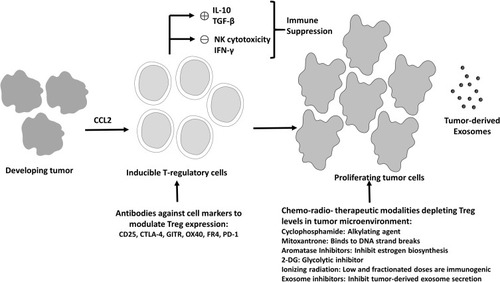Figures & data
Figure 1 Model of immune evasion by tumor cells. Cancer cells modulate several pathways leading to defective antigen presentation, secretion of immunosuppressive mediators [immunosuppressive cytokines like IL-10, vascular endothelial growth factor (VEGF), transforming growth factor (TGF-β), immunosuppressive enzymes like indoleamine 2,3 dioxygenase (IDO), etc], tolerance and immune deviation, apoptosis and release of immunosuppressive cells (Treg cells), which evade immune responses by induction of immune checkpoints like PD-1 and CTLA-4, absence of co-stimulatory molecules like GITR and OX40. These are some of the primary mechanisms involved in tumor cells mediated immune evasion.
![Figure 1 Model of immune evasion by tumor cells. Cancer cells modulate several pathways leading to defective antigen presentation, secretion of immunosuppressive mediators [immunosuppressive cytokines like IL-10, vascular endothelial growth factor (VEGF), transforming growth factor (TGF-β), immunosuppressive enzymes like indoleamine 2,3 dioxygenase (IDO), etc], tolerance and immune deviation, apoptosis and release of immunosuppressive cells (Treg cells), which evade immune responses by induction of immune checkpoints like PD-1 and CTLA-4, absence of co-stimulatory molecules like GITR and OX40. These are some of the primary mechanisms involved in tumor cells mediated immune evasion.](/cms/asset/4e1f77c5-273c-4e86-806f-e92bf586377d/dcmr_a_12186856_f0001_b.jpg)
Figure 2 Imbalances in the immune system homeostasis results in a disease state. A balance in the levels of Treg and T effector cells maintains the homeostatic and disease-free state. A shift in the balance towards Tregs causes a decrease in anti-cancer immunity, resulting in cancer. Contrarily, a shift in the balance towards T effector cells causes a decrease in Treg levels and T effector cells hyperactivation leading to auto-immune disorders.

Table 1 Current Status Of Anti-Cancer Therapies Influencing Treg Levels
Figure 3 Current Treg therapeutics targeting cancer. Treg cells mediated immunosuppression orchestrated by immunosuppressive mediators like IL-10 and TGF-β leads to reduction in antitumor immunity (IFN-γ production and NK cells induced tumor cell cytotoxicity), resulting in excessive tumor cells proliferation. Several strategies such as antibodies targeting the important molecules for Treg activity or small molecule inhibitors, ionizing radiation and exosome inhibitors, which reduce the Treg cell number and activity represent the currently available modalities for Treg depletion and enhanced anti-tumor activity.

